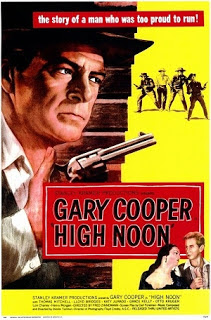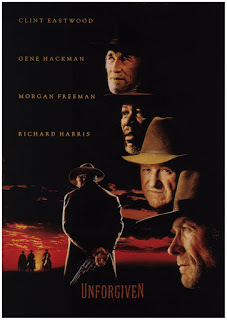The Western is, perhaps, the prime means by which
America understands and symbolizes its history to itself. Westerns are set
within such period of American history, around 1860-1900, in which America
began to construct the nation that it is today and to falsify its identity.
Many characters portrayed on film are men who really lived in that time. The
Western is one of the oldest genres, since 1904 barely a year has gone by
without a Western film being made; there have been musical Westerns, comic
Westerns and television Westerns. The western films have always reflected the
society of the time. “The High Noon” (1952) and “Unforgiven” (1992) are such
movies, which reflect the society of their time.
The High Noon
 Will Kane (Gary Cooper), the
longtime marshal of Hadleyville, has just
married pacifist Quaker Amy Fowler (Grace Kelly) and rotated in
his badge. He intends to become a storekeeper somewhere else. Unexpectedly, the
town comes to know that Frank Miller (Ian MacDonald)
was a criminal whom Kane brought to justice and is due to arrive on the noon
train. Miller had been penalized to hang, but was forgiven on an
unspecified legal trifle. In court, he had promised to get revenge on Will
and anyone else who got in the way. Miller's gang members are his younger
brother Jack Colby (Lee Van
Cleef), Ben (Sheb Wooley),
and Jim Pierce (RobertJ. Wilke),
and they wait for him at the station.
Will Kane (Gary Cooper), the
longtime marshal of Hadleyville, has just
married pacifist Quaker Amy Fowler (Grace Kelly) and rotated in
his badge. He intends to become a storekeeper somewhere else. Unexpectedly, the
town comes to know that Frank Miller (Ian MacDonald)
was a criminal whom Kane brought to justice and is due to arrive on the noon
train. Miller had been penalized to hang, but was forgiven on an
unspecified legal trifle. In court, he had promised to get revenge on Will
and anyone else who got in the way. Miller's gang members are his younger
brother Jack Colby (Lee Van
Cleef), Ben (Sheb Wooley),
and Jim Pierce (RobertJ. Wilke),
and they wait for him at the station.
Amy and Will leave town, but fearing that the gang will be
a danger to the town and its people and also hunt him down, Will turns back;
and he reclaims his badge and scours the town for help, even interfering Sunday
church services, with little success. His assistant, Harvey Pell (Lloyd Bridges), quits because
Will did not recommend him as the new marshal. Harvey decides to stay if Will
would support him; however, Will rejects to buy his assistance. Will goes to
warn Helen Ramírez (Katy
Jurado), first Miller’s lover, the then Will's, and now Harvey's. Helen
already know what Miller will do to her if he discovers her and has sold her
business. She gets ready to leave town to avoid Miller and also to avoid seeing
Kane killed. Amy gives Will an ultimatum if he comes with her on the noon train.
The judge who penalized Miller is leaving and encourages
Will to do the alike. The marshal who heralded Will supports him; however, he
is too old to help Will. Will tries stimulating help from the locals at a bar
and then tries the church. No one at either place responds, and few support
him. Some even wish to see Kane's probable death. Many of the townspeople encourage
Will to leave in the hope that would resolve the situation. In fact, Will's
good friends the Fullers are confused about how to cope with the situation.
Mildred Fuller (Eve McVeagh) wants her husband, Sam (Harry Morgan), to talk to
Will when he comes to their home, but he makes her claim he is not home as he
hides in another room.
Finally, Will faces Miller and his gang all alone. Kane
kills Ben Miller and Colby, but gets wounded in the fight. Amy and Helen both
board the train, then Amy gets off when she hears the sound of gunfire. Amy
prefers her new husband's life over her religious views and beliefs, shooting
Pierce from behind. Miller then takes her hostage to force Will come on
surface. Nevertheless, Amy abruptly attacks Miller, providing Will a clear
shot, and Will shoots Miller. As the townspeople come, Will stares at the
crowd, scornfully throws his marshal's star in the dirt, and then leaves town
with Amy.
“Unfogiven”
The film is set in 1881 in Big Whiskey, Wyoming, where
Little Bill Daggett, former gunfighter and the local sheriff, does not permit
guns and criminals in his town. Two cowboys Davey-Boy and Quick Mike. Bunting,
deface prostitute Delilah Fitzgerald after she laughs at the small size of
Quick Mike's penis. Little Bill allows them to pay compensation to the brothel
owner, Skinny Dubois despite punishing the cowboys. The rest of the
prostitutes, led by Strawberry Alice, are furious by this leniency and offer a
$1,000 reward to one who can kill the cowboys. Miles away in Kansas, the
Schofield Kid, an arrogant young man, visits the pig farm of William Munny,
looking to recruit him to help kill the cowboys. In his youth, Munny was a
thief notorious as a cold-blooded murderer.
Now a regretful widower raising two children, he has left
drinking alcohol and killing. Though Munny firstly refuses to support, his farm
is failing, putting his children's future in danger. Munny reconsiders a few
days later and sets off to catch up with the Kid. Munny recruits Ned Logan, who
is another retired gunfighter.
Logan, Munny and the Kid arrive later during a rain storm.
They go to the saloon to find the cowboys' location. With a bad temperature
after riding in the rain, William Munny is sitting alone in the saloon when
Little Bill and his assistants arrive to face him. With no idea of Munny's
past, Little Bill beats him and takes him out of the saloon after finding a
pistol on him. The Kid and Logan, upstairs getting advances in kind on their
expense from the prostitutes, run out from a back window. The three rearrange
outside of town, where they nurse Munny to recover.Three days later, they trap
a group of cowboys and kill Bunting. Munny and Logan no longer have much
stomach for murder. Logan chooses to return home while Munny feels they must
finish what they started. Munny and the Kid move to the cowboys' farm, where
the Kid traps Quick Mike in an outhouse and kills him. After they run from
there, a distraught Kid admits he had never killed anyone before. Munny
recommends him to drink more whiskey to numb the pain. The Kid rejects life as
a gunfighter and plans to go home.
When Little Sue meets the two men to give them the
prostitute's reward, they come to know that Logan was seized by Little Bill's
men and tortured to death. He had exposed the names of his two partners before
dying, after which his corpse was showed outside the saloon. The Kid moves back
to Kansas to give the reward money to Logan's wife and Munny's children. Munny returns
to town to avenge on Little Bill. That night, Munny arrives and sees that
Logan's body is indeed displayed in a coffin outside the saloon. Inside, Little
Bill has gathered a posse to pursue the Kid and Munny. Munny walks in and kills
Skinny Dubois, the saloon owner. After some tense dialogue, a gunfight ensues,
Bill wounded gets injured and several of his partners die. Just as Bill feebly
lifts his pistol and cocks it, Munny turns back and kicks it from his hand,
killing him. Munny threatens the townsfolk before eventually leaving Big
Whiskey, saying that he will return to exact more vengeance if Logan is not
buried appropriately or if any of the prostitutes are abused.
Comparison
No doubt, the study of Westerns enables us to observe and
examine the issues about North America’s legends and myths. These movies enable
us to look and know how America thinks and feels about itself and its history.
The western genera help explore how men and women fit into the community; and
to look at those external or on the edge of it. Moreover, the fame of any myth
is rooted in its power to reflect and reproduce a society’s values, beliefs and
fears in an edible form. Analyzing and studying the “The High Noon” and
“Unforgiven” enables us to examine the building of a nation and its identity,
patriotism, honor and revenge, male friends and the triumph of good over evil.
The Western genre was employed to enlighten an
uncharacteristic social problem tale about social responsibility, without much
of the usual frontier violence, or tribes of marauding Indians, or panoramic
landscapes. The film was different from the previous ones. The High Noon
reflected the society of the time. In comparison to the previous films, the
shallow characters were replaced with the more life-like characters. The High
Noon explores themes of duty, integrity and honor among the general
citizenry. Despite standing alone, leading character stands firm. This
film could possibly be the representation of the harsh burdens of military power
and liberty.
Unforgiven reflects the last phase known as the
contemporary western. In the 1990’s the western was a marginal genre.
Nevertheless, from time to time, a few successful western movies like
Unforgiven emerged, which proved, that the genre is still popular among the
audiences. Costner’s movie can be also seen as a revisionist western, because
it depicts the white male officers in an appalling light, in contrast to the
Native Americans, who are presented as peaceful naïve peoples. The contemporary
western often deals with psychological, gender and social issues as what
Unforgiven reflects.
The production of the movies in the 1950’s was different.
The movies were black and white and the sounds were not in advanced form.
Therefore, Unforgiven has come to be more advanced comparing to The High Noon.
Though High Noon was an epic of the time, the direction was perfct, the
Unforgiven was made in the modern lines. The lighting, color and the sound were
more advanced giving it a perfect and actual form. The plot of these two movies
do not vary much as both are reflecting the society of the time. The camera and
camera work are different. With the advancement of technicalities, Unfogiven
shows more realistic videography than that of High Noon. In short, the modern
technical aspects make Unforgiven better to eyes and ears comparing it to the
High Noon.

0 comments:
Post a Comment